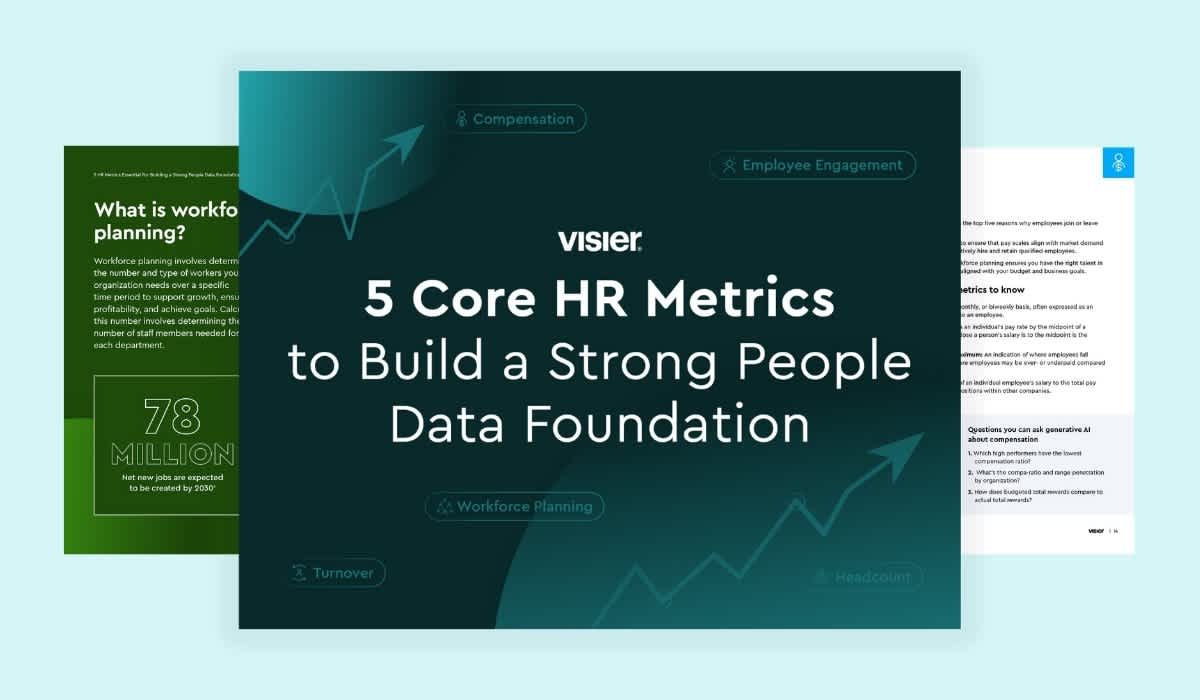What are People Metrics and Why Should You Track Them?
People metrics are a way to review important people data to analyze and measure how effective your people strategies are. Learn more.

People are one of the most important assets in your company. Without the right employees, all your strategies and plans risk failing. People metrics are a way to measure and analyze how effective your talent strategies are.
They include various data points about your workforce such as demographics, compensation, skills, attrition, and more. Metrics are, after all, a way to assess a part of your business.
But why are people metrics important? And which ones should you track? We’ll talk about all this and more.
Why should you track people metrics?
People metrics help you review and analyze important data about your workforce. They can also be crucial when you need to make quick decisions or while responding to a crisis. Because crises, such as the COVID-19 pandemic, often come with difficult choices. If you don’t track the right metrics, your decisions might be rushed and wrong.
But people metrics aren’t all about crises. They’re about business performance too. Tracking things like employee attrition rates, absenteeism, engagement, or diversity could boost performance and sales.
Some say metrics also help you measure the health of your organization. And that’s true for people metrics too. If your employees are unhappy, if they’re skipping work, or if you simply don’t have enough people, your company will struggle.
The top 7 people metrics to track
People metrics are key to a well-performing business. Here are the seven most important ones to track.
1. Headcount
Headcount measures the total number of people working in your organization at a given time. It includes everyone from those working full-time, part-time, as gig workers, and as contractors.
Why you should track headcount
Estimates say that about 70% of an organization’s budget goes toward its workforce. So having an accurate headcount is crucial to avoid wasting money.
But that’s not all. Your headcount can also tell you if you have enough human resources to carry on day-to-day activities. Plus, when you track the headcount, you can easily spot other problems such as a sudden increase in attrition rates.
How do you calculate it?
The total headcount is the sum of all the people working in your organization. It doesn’t matter if they work full-time or if they’re contractors or part-time workers.
If you prefer, you can have separate metrics for the permanent versus temporary headcount, or full-time versus part-time.
2. Employee net promoter score
The employee net promoter score (eNPS) is a good indicator of employee engagement and satisfaction.
Why you should track the employee net promoter score
Employee engagement is crucial for the well-being of your organization. It’s a known fact that engaged employees perform better.
But employee satisfaction and engagement are hard to calculate. So we need to look at more specific metrics. The eNPS is one of them. The net promoter score is a numerical value that measures the employees’ sentiment towards their employer.
How do you calculate it?
Measuring the eNPS is simple. Ask your employees how likely they are to recommend the organization as a place to work. They need to select a number between 0 and 10, where 10 means they would 100% recommend it, while 0 means they would never recommend it.
Employees who select a score between 9 and 10 are the promoters. They are the happiest with their job and their employer.
Those scoring between 0 and 6 are the detractors. These are employees that will most likely speak negatively about the company.
Finally, those scoring 7-8 are passive.
The eNPS will be calculated with the formula: % promoters – % detractors.
3. Diversity
Diversity refers to several factors including ethnicity, gender, or location. More and more people value diversity in the workplace. So much so that 76% say diversity is a factor they consider when looking at a job offer.
Why you should track diversity
A diverse workforce is more creative and performs better. It helps people feel included and lowers the risk of certain employees feeling stuck behind a glass ceiling.
Unfortunately, it is easy to lose track of this idea. Your focus is first and foremost to hire based on skills and experience, which is understandable. But that also means you might not have diversity on your mind when selecting candidates.
Eventually, this might backfire and lead to unhappy employees. By tracking diversity as a metric, you can make sure this doesn’t happen.
How do you calculate it?
To calculate diversity, you need to get the total headcount. Once you have that number, it’s time to go deeper. Look at gender, race, or location.
The factors used in the calculation will vary from business to business. In certain areas, location or race will not be taken into account because of the demographics of your place of business. Adapt accordingly and monitor this metric regularly.
4. Attrition
Attrition represents the number of employees that leave the business. This can be either through voluntary or involuntary turnover or retirement.
Why you should track attrition
Replacing an employee comes with costs. You’re investing resources in the hiring process but you might also lose revenue while the position goes unfilled.
How do you calculate it?
To calculate attrition or turnover rates, you first need to select your reporting period. Let’s say, for instance, that you want to have the attrition rate for the past 12 months.
The attrition rate is the total number of employees that have left the organization divided by the number of employees at the beginning of the reporting period.
In general, this means that a shorter period will return a smaller attrition rate. That’s why in many companies it is common to calculate the annualized attrition rate. This is obtained by using the formula: 12 x attrition / no. of months in the reported period.
5. Absenteeism
Absenteeism refers to how often someone uses their days off, whether it’s sick days or for other personal reasons.
Why you should track absenteeism
Absenteeism rates can give you hints about how healthy, happy, and engaged your employees are. For instance, a person who is frequently taking days off could be dealing with burnout. Or they may feel like they’re not valued and might be searching for other opportunities.
High absenteeism rates are a sign that something is not right. It can also be a sign they’ll soon be quitting. Tracking this metric will help you notice problems as soon as they appear and it might help you resolve them.
How do you calculate it?
Calculating the absenteeism rate requires a simple formula.
Absenteeism = Total no. of workdays missed / No. of permanent employees
6. Total cost of workforce
The total cost of workforce (TCOW) consists of the full costs of people working in your organization. It also includes employer taxes, facilities, and other overhead costs.
Why you should track the total cost of the workforce
Tracking TCOW is essential if you want to stay competitive and create an efficient workforce plan.
TCOW allows you to understand and communicate how various business decisions might impact your company in the future. And it allows you to navigate the current economic climate and respond to tight labor markets.
How do you calculate it?
The total cost of workforce is calculated by adding HR data such as headcount, salaries, and benefits to financial data (workforce overheads) and market data (salary ranges and unemployment per region).
7. Cost per hire
No matter how good you are at retaining employees, eventually, you’ll need to hire new people. Whether that is to replace someone who left or to fill a new position, hiring will generate costs.
Why you should track the cost per hire
The cost per hire can help you assess the effectiveness of your hiring process. Often you’ll need to use it in parallel with other metrics, such as the time to hire, or the time to productivity.
But even on its own, it can be a good indicator of whether your hiring process is effective or if it could use some improvements. You may also use it as a budgeting tool.
How do you calculate it?
The cost per hire is the sum of the external and internal costs divided by the total number of hires during a certain period.
Key takeaways
Tracking people metrics is a must if you want to increase performance and productivity in your business. Taking a data-driven approach to analyzing your workforce will help you avoid mistakes and resolve issues early on.
There are several metrics you can track. From headcount to diversity, attrition, or cost per hire, they will all help you stay competitive and make the correct business decisions at the right time.


